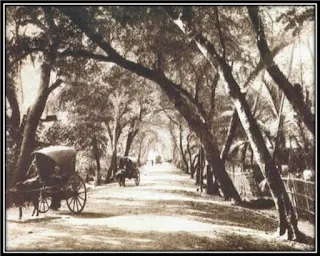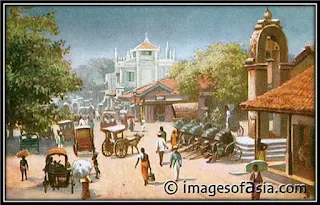Breakwater, Colombo. Ceylon
Colombo Harbour and Shipping
The name Colombo is derived from the Sinhalese word "kola-amba-thota", meaning "Harbour with leafy mango trees." Since Colombo was a convenient resting place for ships from Arabia to Southeast and Far East Asia, as well as a gateway to the cinnamon resources of the former island of Ceylon, it has been an important port for centuries. During World War II, it became a major re-supply station for Allied forces in Asia as well.
Colombo Race Course Governor's Cup Day - 03rd August 1929
Colombo Town Hall, Ceylon, Late 1800's
Colpetty Bazaar, Colombo, Ceylon
Colpetty, or Kollupitiya, Bazaar is a thin strip of land which lies alongside the Galle Road Colpetty Bazaar, along with the Fort area, was the hub of the early British colonial presence in Colombo. The famous Galle Face Hotel is situated at the northern end of Colpetty Bazaar.
Early Days of Chatham Street in Fort, Colombo
Galle Face Green Colombo
Panoramic view of Galle Face Colombo, Sri Lanka around 1880s-1900, looking south from Galle Road (later this path became the Galle Road), Club House & Galle Face Hotel (far right) showing in the background.
Gordon Gardens (later Queen’s House) Colombo, Ceylon, 1924
On February 1, 1804, the British Government took over the private house of the last Dutch Governor in Ceylon, Johan Gerard van Angelbeek in the heart of Colombo Fort. This is the house that became the official residence of the British Governor and was referred to as Queen’s House – so named because the British monarch at the time was Queen Victoria. Queen’s House, was set in about 4 acres of land and the residence gained further attraction when Governor Sir Arthur Hamilton Gordon (1883-90) laid out the Gordon Gardens at his own expense in honour of Queen Victoria’s golden jubilee celebrations in 1887. The Gardens boast of an amazing variety of trees and a marble statue of Queen Victoria which was removed from the gardens in 2006. Gordon Gardens was a public park opened to the public until 1980 when it was made part of the President’s House and today is off-limits to the public.
Grand Oriental Hotel, Colombo
The Grand Orient Hotel, or GOH as it is commonly known, is located on the waterfront in Fort Colombo. The GOH was built in 1837 for the British soldiers. In 1875 it was converted into a hotel. The hotel was also known as the "Taprobane" and was extremely popular among ship passengers and local residents for its ballroom dancing and luxury. Furniture and crockery from the hotel became style and fashion items. Today the hotel continues to flourish after renovations in the 1990s. The many fine hotels in Colombo reflect the city's popularity as a transit port during the 19th and early 20th century among passengers going to Far East Asia from Europe.
House boat in Wellawatta Canal, Ceylon, Late 1800's
Main Street showing Khan Clock Tower, Colombo, Ceylon
The Khan Clock Tower was built around the turn of the nineteenth century. A prominent Colombo landmark, it stands at the entrance to the Pettah markets. The Tower was built by a wealthy Parsi family of Bombay, which also owned the famous Colombo Oil Mills. In this old photo of Sri Lanka the clock tower can be seen in the center background.
Prince Street & York Street intersection, Fort, Colombo
Later view towards the Pettah from the intersection of Prince Street and York Street, Fort, Colombo. Grindlays Bank building and Gaffoor Building, with two additional floors, is visible on the left facing the Bristol Building and YMBA building on the right. Cargills building is visible on the near right besides the tree and the parked vintage cars.
Colombo, Capital of Ceylon - 1980s
Picture taken from Janadhipathi Mawatha (formally Queens Street) in Colombo Fort. Galle Face Green and the Beira Lake could be seen in the background. Colombo was made the capital of Sri Lanka (then Ceylon) in 1815 under British rule. Prior to the British rule, Colombo had been occupied by the Portuguese until 1656, and by the Dutch from 1656 until 1796. All three of these nations wanted control of Ceylon in large part to safeguard their trade in ivory, cinnamon, elephants and sapphires.
Galle Face Green Colombo, Ceylon, Late 1800's
Street Scene in Pettah Colombo, Late 1800's
The Bambalapitiya Road, Leading to Mount Lavinia, Ceylon, Late 1800's
The entrance, Mount Lavinia Hotel, Ceylon
The Mount Lavinia Hotel was originally built in 1806. After falling into disrepair, Mount Lavinia House was rebuilt in 1830 by the British Governor Edward Barnes at a cost of 30,000 pounds. It was designed along the lines of "Banqueting Palace" in Whitehall, London designed by the architect Inigo Jones. Like an Italian villa, the house had a coach house, and military barracks and quarters. Mount Lavinia was home to five British Governors. When the British government had finished using the Governor's residence it was converted into the world famous Mount Lavinia Hotel. Scenes from the movie "Bridge on the River Kwai" were filmed here. Mount Lavinia was home to five British Governors. When the British government had finished using the Governor's residence it was converted into the world famous Mount Lavinia Hotel.
The Museum, Colombo
The National Museum of Colombo was established in 1877. The Colombo Museum is the largest and oldest museum in Sri Lanka. It was established under the reign of the British Colonial Governor, Sir William Henry Gregory. The museum was designed in an imposing Italian style by James G. Smither.
Banyan Tree - Colpetty, Ceylon
Berre Lake Colombo, Early 1900s
Beira Lake is in the heart of the city of Colombo, Sri Lanka and surrounded by many important businesses. Lake occupied approximately 165 hectares of land in early 1900s and it has been reduced to mere 65 hectares today.
Union Place Colombo, Ceylon, Late 1800's
Upper Chatham Street, Fort, Colombo
Subsequent Development of Upper Chatham Street, Fort, Colombo, leading to the Indian Ocean on the Western Coast. Bullock carts lined up along the stretch of shops was used as the mode of transport of goods and people.























3 ප්රතිචාර:
ඉහලම වින්දනයක් ලැබූ රූප රිමු පෙලක් ඉදිරිපත් කල ඔබට ගොඩාක් ස්තුථියි
The to wear the high heels of four years old methods
Opt to wear pumps? Wear will foot pain, backache? jimmy choo pumps Experts educate you on make use of high heel, enable you to be a wholesome and tall!
1, the right gifts soles of trainers according to the curvature within their feet. Top of toe front and shoes has to be left Several cm gap, heel not really that small, the toe ought to be relaxed. The heel height is the most suitable not more than five centimeters.
, Wearing ladies high heel sandals when walking posture are suitable to be correct, the toe is easy, buttocks clamping the top body straight. This prevents pressure uneven distribution, thus improving the leg, foot swelling phenomenon, promote flow of blood, beyond your leg pain.
3, high heel sandals Note occasion, really don't cars around clogged or wear driving uneven making it not Rush Run, this is not to the ice climbing. Commonly do not always wear only one high heel sandals to give up same position through the feet are often squeezed.
Wear high heel slides wander should be conscious of rest, can tilt jimmy choo shoes on salethe toe, and activities of the leg. The toenails really should not short in order to paronychia.As the phrase goes, the shoe fits, feet know. Many studies indicate that stiletto heel shoes are not shipped to ergonomic principles, to influence ladies friend to discontinue the impossibly bright high heel dress shoes is clearly not practical, to stay fashionable but also because of healthy, truly meet the requirements of urban women wear stiletto heel shoes. Therefore, whether a female friend can right decision of high heels and wearing high heel, belonging to the foot care products, are generally good at preventing the occurrence of foot disease.
I Really Love the top header look and feel, very well written.
did you do it yourself?
Also visit my web site ... not On the high street baby
Post a Comment